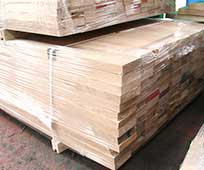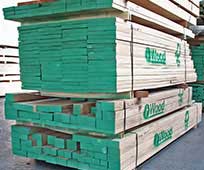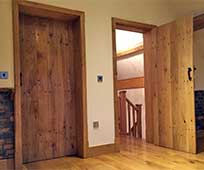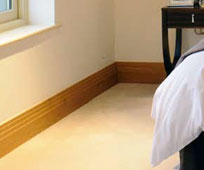Dark Red Meranti - Buy Online
Meranti is a tropical timber that is easy to work with and capable of a smooth finish. Because of this it's often used in furniture making an interior joinery. It is fairly durable and can be used outdoors if treated correctly with a preservative.

Get prices for Dark Red Meranti
Please note that these images are to illustrate product type only and are not species specific.
Dark Red Meranti Information
Appearance
As the name suggests, the timber is red-brown to dark-red. The texture is coarse but even.
Introduction
The genus Shorea produces a number of distinct commercial timbers, some of which are provided by several botanical species. The nomenclature is somewhat involved as the trade names vary according to the country or origin. The timbers are classified for export mainly on the basis of colour and density. It should also be noted that the botanically associated genera, Parashorea and Pentacme produce similar timber to meranti, and may be included with shorea in commercial parcels under a separate trade name. For example, Meranti is the group name for species of shorea in Malaysia, Sarawak, Brunei and Indonesia. Seraya is the group name for species of shorea and parashorea in Sabah Lauan is the group name for species of shorea, parashorea and pentacme in the Philippines. These are all light to medium-weight timbers. The heavy species of shorea belong to the balau group of Malaysian species and this group is roughly equivalent to selangen batu, which is the name used for similar timbers in Sarawak and sabah. Other timbers in this group are chan of Thailand and sal of India. There is considerable variation in colour of the wood in certain species, and for this reason may be classed as light or dark according to the colour of a particular piece. Thus the lighter-coloured timber of shorea acuminata in Malaysia is commonly classed light red meranti while the darker-coloured wood is included with dark red meranti. Shorea pauciflora Shorea curtisii Shorea accuminata Shorea platycarpa Shorea platyclados Are the principal species producing dark red meranti from Malaysia. The alternative Malaysian name for the wood of shorea pauciflora is nemesu Shorea pauciflora is the principle species producing dark red seraya from Sabah, locally known also as obu suluk.
Other Names
Shorea Family: Dipterocarpaceae
The Tree
The various specie of shorea grow to a height of 45m or so and a diameter of 1.2m or a little more, with long, clean, cylindrical boles above small buttresses.
The Timber
Sapwood lighter in colour and distinct from the heartwood which is red-brown darkening to a dark red ; planed surfaces fairly lustrous, stripe figure on radial surfaces. Grey-coloured narrow streaks are often present on all longitudinal surfaces, caused by concentric layers of resin canals. The texture is rather course but even, and the grain is interlocked and wavy. The wood weighs on average, 710 kg/m3 when dried.
Durability
Durable
Drying
The various types of meranti/seraya are reported to dry rapidly and well, with little degrade. Some slight distortion and surface checking may occur in the denser types, ‘Malaysian Forest Service Trade Leaflet No 8’ gives the following information regarding the air drying for red meranti dried under cover in Malaysia. From about 60 per cent moisture content to 18 per cent moisture content: - 25mm boards 2 to 3 months 38mm boards 3 ½ to 4 ½ months 50mm boards approximately 5 months
Strength
There is a wide variation in the strength properties of the various merantis and red seraya due to the differences in density and the number of species involved. Large, over-mature logs are frequently spongy in the heart, the wood in these areas being weak and brittle. Despite the fact that the best type of light red meranti is almost equal in strength to the weakest type of dark red meranti, there is nevertheless on average, a distinct difference in mechanical properties. The average figure for strength and stiffness in bending and compression for dark red meranti is about 20 per cent higher than that for light red meranti ; in shear there is about 10 per cent difference, and in hardness over 30 per cent.
Working Qualities
The wood of the various species work well and in general are capable of a good smooth surface, but a reduction of cutting angle to 20 degrees is beneficial where a tendency for the grain to tear becomes apparent. The dulling effect on saws and cutters varies somewhat with the species, but is usually quite small. The various species can be glued, nailed and screwed satisfactorily, and can be stained and polished quite well after suitable filing.
Uses
Joinery and general construction and also furniture, particularly for interior framing and drawer sides and backs, dark red meranti, due to its higher durability factor, allows for its use in more exposed situations, for example for cladding, particularly when treated with a preservative.







 Main Menu
Main Menu





